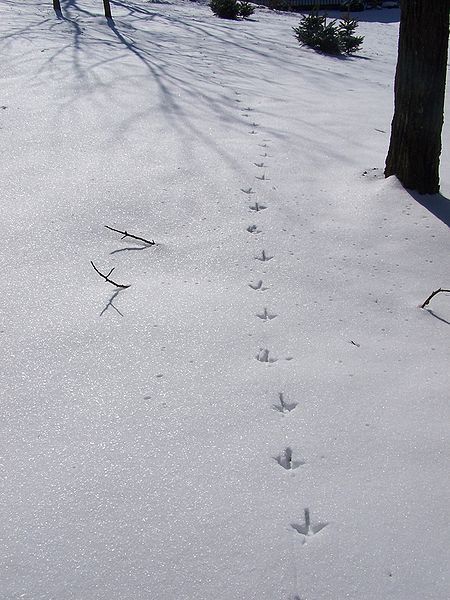
One of the best things about snow is that you can see who’s been there before you and guess what they were doing.
Last weekend at Moraine State Park I was pleased by the tracks in the snow. My favorites were made by a red fox who walked at least a mile on the North Shore bike trail. For the most part he just put one foot front of the other, literally placing each back foot in the print of his front foot like a cat. On and on he walked until…
Something caught his eye and he broke into a gallop. He rushed at a pine tree with squirrel tracks at its base but his prey must have escaped. No blood, no struggle in the snow, and the fox resumed his walk with only one backward glance as if nothing had happened.
Behind him came a coyote who walked only a short section of the bike trail, then veered off to a thicket for some serious hunting. His prints showed him sniffing in all the corners, then digging near a culvert. Something edible must have been hiding there. I saw rabbit and vole tracks but were they what he was after? I don’t know.
Birds make tracks, too. Shown above are the tracks of a wild turkey walking alone in the snow. It would have been fun to find out where he went and if any other turkeys joined him.
So despite the cold I’m not tired of the snow (yet). I’m out looking for tracks!
(photo by Tim Engleman of Saxonburg, PA via Wikimedia Commons. Click on the photo to see the original.)
I too enjoy tracks. I can see when deer are in my yard & what they are after — they usually stop at the bird feeders, and sometimes a bush or two, and occasionally in my veg. garden to sip the water in my heated dog dish bird bath. I also recognize bunny tracks, and those of crows. Love the feathery little bird tracks — they obviously have so little weight the tracks are barely there. And there are what I think are mouse tracks. Etc. etc.
This is not on point, but I never seem to know where to post what!
There was a story in the local paper this week that the Hawk Mtn (Kittanniny) Bird Watch has ended for this season, and the great news was that they counted over 450 bald eagles migrating through! (Avg over past years was 200+) Many factors are cited, including wind patterns that might have brought the birds closer to the peak, but it’s unmistakable that the population is recovering soundly.
The story said that, in the ’70s, a watcher brought a bottle of champagne that he’d pop and share if they saw even one! Hope those days are gone forever!
We are just back from the Caribbean, where we go for a week each yr to RAGE against the dying of the light! LIAT Airline magazine featured the peregrine as its Bird of the Issue. (The mag is Zing, and I read the Oct-Dec issue, but I don’t know if it’s online.) It’s described as uncommon to rare, but found throughout the West Indies Oct-April in coastal areas, offshore cays and rocks, woodlands, forests and cities. In other words, just about everywhere is a possible sighting area! One breeding record in Cuba and one in Domenica.
We saw lots of hummingbirds, anis, one frigate bird on a stormy day, doves, and a bird I want to call a ruby-throated sparrow–to honor Steven Stills and Judy Collins–but her throat was actually bronzish. She didn’t sing for us, altho she sat on our balcony and waited for non-coming treats!
Oh! A gecko tried to attack my toenail as I sat quietly drinking morning coffee! Guess that’ll teach me not to paint my toenails RED! I don’t know which of us was more startled!
Anne
We have many birds who visit us daily: chickadees, tuffed titmice, red and white breasted nuthatches, woodpeckers, cardinals, bluejay, and more. They have gotten so used to us that we can go outside and, if we stand very still, they will come and eat out of our outstretched hands. They fly around my husband’s head and nosedive to the pocket on his jacket. That’s where he puts the bird seed we are feeding them and they see him pulling it out. Paula